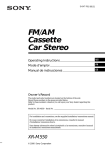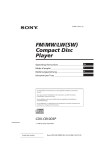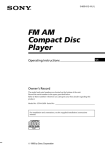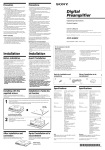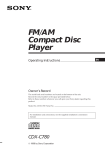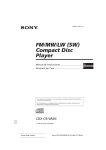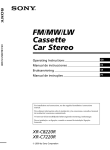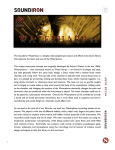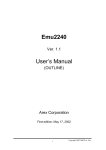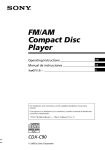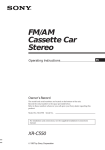Download Sony XR-C9100 User's Manual
Transcript
FM/AM Cassette Car Stereo Operating Instructions Owner’s Record The model and serial numbers are located on the bottom of the unit. Record the serial number in the space provided below. Refer to these numbers whenever you call upon your Sony dealer regarding this product. Model No. XR-C9100 Serial No. For installation and connections, see the supplied installation/connections manual. R XR-C9100 1998 by Sony Corporation EN EN Warning Welcome ! This equipment has been tested and found to comply with the limits for a Class B digital device, pursuant to Part 15 of the FCC Rules. These limits are designed to provide reasonable protection against harmful interference in a residential installation. This equipment generates, uses, and can radiate radio frequency energy and, if not installed and used in accordance with the instructions, may cause harmful interference to radio communications. However, there is no guarantee that interference will not occur in a particular installation. If this equipment does cause harmful interference to radio or television reception, which can be determined by turning the equipment off and on, the user is encouraged to try to correct the interference by one or more of the following measures: — Reorient or relocate the receiving antenna. — Increase the separation between the equipment and receiver. — Connect the equipment into an outlet on a circuit different from that to which the receiver is connected. — Consult the dealer or an experienced radio/ TV technician for help. Thank you for purchasing this Sony Cassette Player. This unit lets you enjoy a variety of features by using a supplied rotary commander or an optional wireless remote. You are cautioned that any changes or modifications not expressly approved in this manual could void your authority to operate this equipment. In addition to the Cassette playback and radio operations, you can expand your system by connecting an optional CD/MD unit*1. When you operate this unit or a connected optional CD unit with the CD TEXT function, the CD TEXT information will appear in the display when you play back a CD TEXT disc*2. *1 You can also connect a CD changer or an MD changer. *2 A CD TEXT disc is an audio CD that includes information such as the disc name, artist name and track names. This information is recorded on the disc. Voice guide for safe driving This unit has a voice guide function*. When the voice guide function is on, the unit gives vocalized comments on functions corresponding the buttons pushed. * Some optional power amplifiers may cause a break at the beginning of vocalized comments. When you connect an optional MD changer, the sound from the first MD may continue for a short time even after the vocalized comments about the second MD are announced. BBE* With BBE, you can obtain a sharp edged bass for a more natural and clear sound. When reproduced from CDs, MDs, tapes, or radio, treble tones have a slight tendency to delay compared with the bass which may result in unclear sound reproduction due to the masking effect of the bass. The BBE reproduces, as close as is possible, the original sound by adjusting the sound balance of the bass. * The BBE is manufactured by Sony Corporation under license from BBE Sound, Inc. It is covered by U.S. Patent No.4,638,258 and No.4,482,866. The word “BBE” and the BBE Symbol are the trademarks of BBE Sound, Inc. 2 Table of Contents This Unit Only With Optional Equipment Location of controls ................................................. 4 Getting Started Resetting the unit ................................................ Detaching the front panel .................................. Preparing the rotary commander ..................... Setting the clock .................................................. 6 6 7 7 Cassette Player Listening to a tape ............................................... 8 Playing a tape in various modes ....................... 9 Radio Memorizing stations automatically — Best Tuning Memory (BTM) ................. Memorizing only the desired stations ........... Receiving the memorized stations .................. Storing the station names — Station Memo .......................................... Locating a station by name — List-up ...................................................... 10 11 11 12 13 Other Functions Using the rotary commander .......................... Adjusting the sound characteristics ............... Attenuating the sound ..................................... Changing the sound and display settings ..... Adjusting the frequency of the subwoofer(s) .......................................... 13 15 15 15 16 CD/MD Unit Playing a CD or MD ......................................... Scanning the tracks — Intro Scan ................................................. Playing tracks repeatedly — Repeat Play .............................................. Playing tracks in random order — Shuffle Play .............................................. Creating a program — Program Memory ................................... Labeling a CD — Disc Memo ............................................... Locating a disc by name — List-up ...................................................... Selecting specific tracks for playback — Bank .......................................................... 17 18 18 18 19 21 23 23 EN DSP Selecting a surround menu .............................. Storing a surround effect onto CDs — Digital Signal Processor (DSP) Custom File ................................................... Selecting the listening position ....................... Adjusting the fader (FAD) ............................... Adjusting the volume of the subwoofer(s) .... Adjusting the volume of the bass and treble ...................................................... Listening to each program source in its registered surround menu — Last Sound Memory (LSM) ................... Changing the line output level ....................... 24 25 26 27 27 28 28 28 TV/Video Watching the TV ............................................... Watching a video .............................................. Memorizing TV channels automatically ....... Memorizing only the desired TV channels ... Storing the TV channel names ........................ Displaying the information stored on discs .. Watching the TV or video while listening to a tape, CD or MD — Simultaneous Play .................................. 29 29 29 29 30 30 31 Additional Information Precautions ......................................................... Maintenance ....................................................... Dismounting the unit ....................................... Specifications ..................................................... Troubleshooting guide ..................................... 32 33 33 34 35 3 Location of controls MODE K/AMS SEE OPEN SOUND DSPL LIST SOURCE SHIFT OFF 1 2 3 4 5 6 7 8 9 10 XR-C9100(U) EN Refer to the pages for details. 1 SEEK/AMS (seek/Automatic Music Sensor/manual search) control 9, 11, 18, 19, 20, 23, 29 2 MODE (*) button During tape playback: Playback direction change 8, 9 During tuner reception: BAND select 10, 11 During CD or MD playback: CD/MD Unit select 17, 19, 22 During TV reception or Video playback: TV/Video select 29 3 SOURCE (TAPE/TUNER/CD/MD/TV) button 8, 10, 11, 16, 17, 19, 22, 24, 25, 27, 28, 29, 31 4 Dial (volume/subwoofer volume/bass/ treble/left-right/rear-front control) 7, 12, 15, 21, 22, 24, 25, 26, 27, 28 5 SOUND button 15, 24, 25, 26, 27, 28 6 DSPL (display mode change) button 9, 12, 13, 17, 22, 23 !¡ LIST button Station Memo 12 List-up 13, 23, 30 Disc Memo 21, 22 DSP Custom File 25 !™ OFF button 6, 8 !£ Sensor for the optional wireless remote !¢ SHIFT button PLAY MODE 9, 10, 11, 18, 19, 20, 21, 23, 24, 25, 29 REP 10, 18 SET UP 7, 16, 17, 28 SHUF 18 !∞ POWER SELECT switch (located on the bottom of the unit) See “POWER SELECT Switch” in the Installation/Connections manual. !§ During radio reception: Number buttons 11 7 Display window During CD or MD playback: Direct disc selection buttons 18 8 6 (eject) button (located on the front side of the unit behind the front panel) 8 During TV reception: Number buttons 29 9 Reset button (located on the front side of the unit behind the front panel) 6 4 !º OPEN button 6, 8, 33 Optional wireless remote (RM-X47) OFF MODE SOURCE DIR SEEK AMS – REW – + PRESET DISC FF SOUND + SEL ATT DSPL EN The buttons of the wireless remote control the same functions as those on this unit. 1 OFF button 2 SEEK/AMS button 7 PRESET/DISC button You cannot do manual search and manual tuning with the remote. 3 (–) (+) buttons 8 SOURCE button 4 ATT button 9 MODE/DIR button (MODE) controls the same function on this unit. 5 SOUND/SEL button 6 DSPL button When the POWER SELECT switch is set to the B position, the unit cannot be operated with the wireless remote unless (SOURCE) on the unit is pressed or a cassette is inserted to activate the unit first. 5 Attaching the front panel Getting Started Resetting the unit Before operating the unit for the first time or after replacing the car battery, you must reset the unit. Press the reset button with a pointed object, such as a ball-point pen. Place the hole a in the front panel onto the spindle b on the unit as illustrated, then push the left side in. a b Reset button Note Pressing the reset button will erase the clock and some memorized functions. µ EN Detaching the front panel You can detach the front panel of this unit to protect the unit from being stolen. 1 Press (OFF). 2 Press (OPEN) to open up the front panel, then slide the front panel to the right side, and pull out from the left side of the front panel. 1 2 Notes • Do not place anything on the inner surface of the front panel. • Be sure not to drop the panel when detaching it from the unit. • If you detach the panel while the unit is still on, the power will turn off automatically to prevent the speakers from being damaged. • When you carry the front panel with you, put it in the supplied front panel case. 6 Notes • Be sure not to attach the front panel upside down. • Do not press the front panel hard against the unit when attaching it. Press it lightly against the unit. • Do not press hard or put excessive pressure on the display windows of the front panel. • Do not expose the front panel to direct sunlight or heat sources such as hot air ducts, and do not leave it in a humid place. Never leave it on the dashboard of a car parked in direct sunlight where there may be a considerable rise in temperature. Caution alarm If you turn the ignition key switch to the OFF position without removing the front panel, the caution alarm will beep for a few seconds (only when the POWER SELECT switch on the bottom of the unit is set to the A position). Setting the clock The clock uses a 12-hour digital indication. Example: To set the clock to 10:08 1 Preparing the rotary commander Press (SHIFT), then press (3) (SET UP). SET UP 1 Press (5) (n). When you mount the rotary commander, attach the label as shown in the illustration below. SET UP The hour digit flashes. 2 Set the hour. SOUND MODE LIST to go backward EN SET UP LIST MODE SOUND Getting Started to go forward 3 Press (5) (n). SET UP The minute digits flash. 4 Set the minute. to go backward to go forward SET UP 2 Press (SHIFT). SET UP The clock starts. continue to next page n 7 3 Press (SHIFT). After the mode setting is complete, the display returns to normal playback mode. Note If the POWER SELECT switch on the bottom of the unit is set to the B position, turn the power on first, then set the clock. Cassette Player Listening to a tape 1 Press (OPEN) and insert a cassette. 6 2 EN Close the front panel. Playback starts automatically. If a cassette is already inserted, press (SOURCE) repeatedly until “FWD” or “REV” appears to start playback. The side facing up is being played. The side facing down is being played. Tips • To change the tape‘s playback direction, press (MODE) (*). • ”Metal” appears in the display when you insert a metal or CrO2 tape (Auto Metal function). 8 To Press Stop playback (OFF) Eject the cassette (OPEN) then 6 Fast-winding the tape During playback, push the SEEK/AMS control up or down and hold. Fast-forward Rewind To start playback during fast-forwarding or rewinding, press (MODE). Locating a specific track — Automatic Music Sensor (AMS) You can skip up to nine tracks at one time. During playback, push the SEEK/AMS control up or down momentarily. To locate succeeding tracks To locate preceding tracks Playing a tape in various modes You can play the tape in various modes: •Intro (Intro Scan) lets you play the first 10 seconds of all the tracks. •NR (Dolby NR) lets you select the Dolby* NR B or C system. •B. Skip (Blank Skip) skips blanks longer than eight seconds. •ATA (Automatic Tuner Activation) turns on the tuner automatically while fast-winding the tape. •Repeat (Repeat Play) repeats the current track. * Dolby noise reduction manufactured under license from Dolby Laboratories Licensing Corporation. ”DOLBY“ and the double-D symbol a are trademarks of Dolby Laboratories Licensing Corporation. Searching for the desired track — Intro scan EN Press (SHIFT). Every time you press (SHIFT), only the items you can select light up. A SET UP PLAY MODE REP SHIFT 1 2 3 4 5 6 7 8 9 Changing the display item Each time you press (DSPL), the item changes as follows: z Tape playback 2 z Clock MOTION DISPLAY* Z Press (4) (PLAY MODE) repeatedly until “Intro” appears. Each time you press (4) (PLAY MODE), the item changes as follows: 1 Getting Started/Cassette Player Note The AMS function may not work when: — the blanks between tracks are shorter than four seconds — there is noise between tracks — there are long sections of low volume or quiet sections. 1 Intro n NR n B. Skip n ATA * All the items above are scrolled in the display one by one in order. PLAY MODE 3 Press (5) (n) to select “Intro on.” PLAY MODE Intro Scan starts. 4 Press (SHIFT). To go back to normal playback mode, select “Intro off” in step 3 above. 9 Playing tracks repeatedly — Repeat Play Radio 1 During playback, press (SHIFT). 2 Press (7) (REP) repeatedly until ”Repeat“ appears. DSPL A SET UP PLAY MODE REP SHIFT 1 2 3 4 5 6 7 8 9 Repeat Play starts. 3 Press (SHIFT). To go back to normal playback mode, select “Repeat off” in step 2 above. 1 Memorizing stations automatically — Best Tuning Memory (BTM) The unit selects the stations with the strongest signals and memorizes them in the order of their frequencies. You can store up to 10 stations on each band (FM1, FM2, and AM). Caution When tuning in stations while driving, use Best Tuning Memory to prevent accidents. 1 EN Press (SOURCE) repeatedly to select the tuner. Each time you press (SOURCE), the source changes as follows: TAPE ˜ TUNER 2 Press (MODE) repeatedly to select the band. Each time you press (MODE), the band changes as follows: z FM1 z FM2 z AM 3 Press (SHIFT), then press (4) (PLAY MODE) repeatedly until “B.T.M” appears. 4 Press (5) (n). The unit stores stations in the order of their frequencies on the number buttons. The setting is stored with a beep sound. 5 Press (SHIFT). Notes • The unit does not store stations with weak signals. If only a few stations can be received, some number buttons will retain their former setting. • When a number is indicated in the display, the unit starts storing stations from the one currently displayed. 10 Memorizing only the desired stations You can preset up to 20 FM stations (10 for FM1 and 10 for FM2) and up to 10 AM stations in the order of your choice. 1 Press (SOURCE) repeatedly to select the tuner. 2 Press (MODE) repeatedly to select the band (FM1, FM2, or AM). 3 Push the SEEK/AMS control up or down to tune in the station you want to store on the number button. 4 Press and hold the desired number button ((1) to (10)) until “MEM” appears. The number button indication appears in the display. Receiving the memorized stations 1 Press (SOURCE) repeatedly to select the tuner. 2 Press (MODE) repeatedly to select the band (FM1, FM2, or AM). 3 Press the number button ((1) to (10)) momentarily where the desired station is stored. If you cannot tune in a preset station Tip If you know the frequency of the station you want to listen to, push the SEEK/AMS control up or down and hold until the desired frequency appears (manual tuning). If FM stereo reception is poor — Monaural Mode 1 Press (SHIFT), then press (4) (PLAY MODE) repeatedly until “Mono” appears. 2 Press (5) (n) repeatedly until “Mono on“ appears. The sound improves, but becomes monaural (“ST” disappears). 3 Press (SHIFT). EN To go back to normal mode, select “Mono off” in step 2 above. If interference occurs during FM reception If there is interference from neighboring stations, follow the steps below and select “Narrow”. If interference is not a problem, select “Wide” to maximize signal reception and improve sound quality or “IF Auto ”to switch between “Narrow” and “Wide” automatically. 1 Press (SHIFT) during FM reception. 2 Press (4) (PLAY MODE) repeatedly until “IF Auto“ appears. 3 Press (5) (n) repeatedly to select desired setting z IF Auto Cassette Player/Radio Note If you try to store another station on the same number button, the previously stored station will be erased. Note If the automatic tuning stops too frequently, press (SHIFT), then press (4) (PLAY MODE) repeatedly until “Local” (local seek mode) is displayed. Then press (5) (n) to select “Local on.” Press (SHIFT). Only the stations with relatively strong signals will be tuned in. z Wide Narrow Z 4 Press (SHIFT). Push the SEEK/AMS control up or down momentarily to search for the station (automatic tuning). Scanning stops when the unit receives a station. Push the SEEK/AMS control up or down repeatedly until the desired station is received. 11 Storing the station names Displaying the station name Press (DSPL) during radio reception. — Station Memo You can assign a name to each radio station and store it in memory. The name of the station currently tuned in appears in the display. You can assign a name of up to eight characters per station. Each time you press (DSPL), the item changes as follows: Storing the station names 1 2 $ Station name*1 Tune in a station whose name you want to store. $ Frequency Press (LIST) for two seconds. $ Clock $ MOTION DISPLAY*2 3 EN Enter the characters. 1 Rotate the dial clockwise to select the desired characters. (A n B n C n ··· Z n 0 n 1 n 2 n ··· 9 n + n – n * n / n \ n > n < n.n_) If you rotate the dial counterclockwise, the characters appear in the reverse order. If you want to put a blank space between characters, select “_” (underbar). 2 Press (5)(n) after locating the desired character. The flashing cursor moves to the next space. If you press (2)(N), the flashing cursor moves to the left. 3 Repeat steps 1and 2to enter the entire name. 4 To return to the normal radio reception, press (LIST) for two seconds. Tip To erase or correct a name, enter “_” (under-bar) for each character. 12 *1 If the station name of a station is not stored, “NO NAME” appears in the display for one second. 2 * All the items above are scrolled in the display one by one in order. Erasing the station name 1 Tune in any station and press (LIST) for two seconds. 2 Press (DSPL) for two seconds. 3 Rotate the dial to select the name that you want to erase. 4 Press (6)(ENTER) for two seconds. The name is erased. Repeat steps 3 and 4 if you want to erase other names. 5 Press (LIST) for two seconds. The unit returns to the normal radio reception mode. Locating a station by name — List-up 1 Press (LIST) momentarily. The name assigned to the station currently playing appears in the display. ENTER 2 Press (LIST) repeatedly until you find the desired station. 3 Press (6)(ENTER) to tune in the desired station. Note Once the station name or frequency has been displayed for five seconds, the display goes back to its normal mode. To turn off the display, press (DSPL). Other Functions Using the rotary commander The rotary commander works by pressing buttons and/or rotating controls. You can control an optional CD or MD unit with the rotary commander. By pressing buttons (the SOURCE and MODE buttons) (SOURCE) EN Each time you press (SOURCE), the source changes as follows: TAPE n TV* n TUNER n CD n MD * When an optional TV tuner or video is connected. Radio/Other Functions (MODE) Pressing (MODE) changes the operation in the following ways; • • • • • Tape playback direction Tuner : FM1 n FM2 n AM CD unit : CD1 n CD2 n … MD unit : MD1 n MD2 n … TV/Video : TV n VIDEO1 n VIDEO2 n … Tip When the POWER SELECT switch is set to position B, you can turn on this unit by pressing (SOURCE) on the rotary commander. 13 By rotating the control (the SEEK/ AMS control) Press (SOUND) to adjust the volume and sound menu. Press (LIST) to: • Display the memorized names. • Display the program type. Changing the operative direction EN Rotate the control momentarily and release it to: •Locate the beginnings of the tracks on the tape. Rotate and hold the control, and release it to fast-wind the tape. To playback, rotate and hold the control again, and release it. •Locate a specific track on a disc. Rotate and hold the control until you locate the specific point in a track, then release it to start playback. •Tune in stations automatically. Rotate and hold the control to tune in a specific station. The operative direction of controls is factoryset as in the illustration below. To increase To decrease If you need to mount the rotary commander on the right side of the steering column, you can reverse the operative direction. By pushing in and rotating the control (the PRESET/DISC control) Press (SOUND) for two seconds while pushing the VOL control. Push in and rotate the control to: •Receive the stations memorized on the number buttons. •Change the disc. •Fast-winds the tape. Other operations Rotate the VOL control to adjust the volume. OFF Press (ATT) to attenuate the sound. Press (OFF) to turn off the unit. 14 Tip You can control the operative direction of controls with the unit (page 15). Changing the sound and display settings You can adjust the bass, treble, balance and fader. You can store the bass and treble levels independently for each source. The follow items can be set: •Clock (page 7). •D.Info (Dual Information) – to display the clock and the play mode at the same time (ON) or to display the information alternately (OFF). •Amber/Green – to change the illumination color to amber or green. •Dimmer – to change the brightness of the display. — Select “Auto” to dim the display only when you turn the lights on. — Select “on” to dim the display. — Select “off” to deactivate Dimmer. •Contrast – to adjust the contrast if the indications in the display are not recognizable because of the unit‘s installed position. •Voice guide function for vocalized comments. — Select “Voice 1” to minimize the volume of the guide. — Select “Voice 2” to be louder the volume than “Voice 1.” — Select “Voice 3” to maximize the volume of the guide. — Select “Voice off” to deactivate Voice guide. •Beep – to turn on or off the beeps. •RM (Rotary Commander) – to change the operative direction of the controls of the rotary commander. — Select “norm” to use the rotary commander as the factory-set position. — Select “rev” when you mount the rotary commander on the right side of the steering column. •BBE – to enjoy bass and treble even at low volume. The bass and treble will be reinforced. — Select “BBE 1” to reinforce the bass and treble. — Select “BBE 2” to reinforce the bass and treble more effectively than “BBE 1”. — Select “BBE off” to deactivate BBE. •LPF (Low Pass Filter) •A.Scrl (Auto Scroll) (page 17). 1 Select the item you want to adjust by pressing (SOUND) repeatedly. VOL (volume) n SUB (subwoofer volume) n BAS (bass) n TRE (treble) n BAL (left-right) n FAD (front-rear) 2 Adjust the selected item by rotating the dial. Adjust within three seconds after selecting the item. (After three seconds, the dial function reverts to volume control.) Attenuating the sound Press (ATT) on the rotary commander or wireless remote. “ATT on” flashes momentarily. To restore the previous volume level, press (ATT) again. Tip The unit decreases the volume automatically when a telephone call comes in (Telephone ATT function). EN Other Functions Adjusting the sound characteristics 15 1 Press (SHIFT). 2 Press (3)(SET UP) repeatedly until the desired item appears. Each time you press (3)(SET UP), the item changes as follows: Clock n D.Info* n Amber/Green n Dimmer n Contrast n Voice* n Beep n RM n BBE* n LPF* n A.Scrl* * When the radio is off, or when there is no tape, CD, or MD being played, these items will not appear. Notes • The displayed item will differ depending on the source. • If an optional digital preamplifier is connected to the unit, BBE and Voice Guide do not work. 3 Press (5)(n) to select the desired setting (for example: on or off). For the “Contrast” setting, pressing (5) (n) makes the contrast higher, and pressing (2)(N) makes the contrast lower. 4 Press (SHIFT). After the mode setting is complete, the display returns to normal playback mode. EN Adjusting the frequency of the subwoofer(s) To match the characteristics of the connected subwoofer(s), you can cut out the unwanted high and middle frequency signals entering the subwoofer(s). By setting the cut-off frequency, the subwoofer(s) will output only low frequency signals for a clearer sound image. 1 Press (SOURCE) to select a source (radio, tape, CD, or MD). 2 Press (SHIFT), then press (3)(SET UP) repeatedly until “LPF” appears. 3 Press (5)(n) or (2)(N) repeatedly to select desired setting. Each time you press (5)(n) or (2)(N), the cut-off frequency in the display changes as follows: LPF 120 Hz ˜ LPF 80 Hz ˜ LPF off 4 16 Press (SHIFT). When the frequency setting is complete, the display returns to the normal playback mode. With Optional Equipment CD/MD Unit You can control up to 7 CD and MD units with this unit. If you connect an optional CD unit with the CD TEXT function, the CD TEXT information will appear in the display when you play a CD TEXT disc. Playing a CD or MD 1 Press (SOURCE) repeatedly to select the CD or MD. 2 Press (MODE) until the desired unit appears. CD/MD playback starts. Changing the display item Each time you press (DSPL) during CD, CD TEXT, or MD playback, the item changes as follows: Tip If the name of the MD or CD TEXT disc is too long, you can scroll it across the display by pressing (SHIFT), then (2) (N). Automatically scrolling a disc name — Auto Scroll If the disc name/artist name or track name on a CD TEXT disc or MD exceeds 10 characters and the Auto Scroll function is on, information automatically scrolls on the display as follows: • The disc name appears when the disc has changed (if the disc name is selected). • The track name appears when the track has changed (if the track name is selected). If you press (DSPL) to change the display item, the disc or track name of the MD or CD TEXT disc is scrolled automatically whether you set the function on or off. 1 During playback, press (SHIFT). 2 Press (3)(SET UP) repeatedly until “A.Scrl” appears. 3 Press (5)(n) to select “A.Scrl on.” 4 Press (SHIFT) $ Elapsed playback time $ Disc name*1/Artist name*2 $ Track name*3 $ Clock $ MOTION DISPLAY*4 *1 If you have not labeled the disc or if there is no disc name prerecorded on the MD, “NO D.Name” appears in the display. *2 If you play a CD TEXT disc, the artist name appears in the display after the disc name. (Only for CD TEXT discs with the artist name.) *3 If the track name of a CD TEXT disc or MD is not prerecorded, “NO T.Name” appears in the display. *4 AII the items above are scrolled in the display one by one in order. EN Other Functions/CD/MD Unit When a CD/MD unit is connected, all the tracks play from the beginning. You can label CD and CD TEXT discs with a personalized name using the disc memo function, refer to “Labeling a CD” (page 21). However, if you use personalized labels, they will always take priority over the original CD TEXT information when such information is displayed. To cancel Auto Scroll, select “A.Scrl off” in step 2 above. Note For some CD TEXT discs with extremely many characters, the following cases may happen: — Some of the characters are not displayed — Auto Scroll does not work. 17 Locating a specific track — Automatic Music Sensor (AMS) During playback, push the SEEK/AMS control up or down once for each track you want to skip. To locate succeeding tracks To locate preceding tracks Locating a specific point in a track — Manual Search Playing tracks repeatedly — Repeat Play You can select: •Repeat 1 – to repeat a track. •Repeat 2 – to repeat a disc. 1 During playback, press (SHIFT). 2 Press (7)(REP) repeatedly until the desired setting appears. z Repeat 1 During playback, push the SEEK/AMS control up or down and hold. Release when you have found the desired point. z Repeat 2 Repeat off Z Repeat Play starts. To search forward 3 Press (SHIFT). To search backward EN Locating a disc by disc number — Direct Disc Selection Press the number button that corresponds with the desired disc number. The desired disc in the current changer begins its playback. Scanning the tracks — Intro Scan You can play the first 10 seconds of all the tracks on the current disc. 1 Playing tracks in random order — Shuffle Play You can select: •Shuf 1 – to play the tracks on the current disc in random order. •Shuf All – to play all the tracks in random order. 1 During playback, press (SHIFT). 2 Press (8)(SHUF) repeatedly until the desired setting appears. During playback, press (SHIFT), then press (4)(PLAY MODE) repeatedly until “Intro” appears. 2 Press (5)(n) to select “Intro on.” Intro Scan starts. 3 Press (SHIFT). To go back to normal playback mode, select “Intro off” in step 2 above. 18 To return to normal playback mode, select “Repeat off” in step 2 above. z Shuf 1 z Shuf All Shuf off Z Shuffle Play starts. 3 Press (SHIFT). To go back to normal playback mode, select “Shuf off” in step 2 above. Creating a program — Program Memory (CD/MD unit with the program memory function) You can play tracks in any order of your choice by creating and storing programs in the unit‘s memory. You can make two programs: Program 1 and Program 2. You can select up to 12 tracks for each program. You can store the programs in the memory. 5 When you finish entering the tracks, press (4)(PLAY MODE) for two seconds. 6 Press (SHIFT). Notes • “**Wait**” appears in the display while the unit is reading the data, or if a disc has not been put into the unit. • “*Mem Full*” appears in the display when you try to enter more than 12 tracks into a program. Playing the stored program 1 Press (SHIFT), then press (4)(PLAY MODE) for two seconds. Program edit mode DISC TRACK PLAY MODE ENTER Changing the disc order in the unit will not affect the program memory play. You can select: •PGM 1 to – play Program 1. •PGM 2 to – play Program 2. •PGM 1+2 – to play Programs 1 and 2. “P 1” indicates Program 1 is selected. If you have labelled the disc, the bank edit mode appears. Press (4)(PLAY MODE) to display “P 1” above. 2 Select the track you want. 1 Press (SOURCE) repeatedly to select CD or MD. 2 Press (MODE) repeatedly to select the unit. 3 Press (SHIFT), then press the number button to select the disc. Press (SHIFT). 2 Press (4)(PLAY MODE) repeatedly until “PGM” appears. 3 Press (5)(n) repeatedly until the desired program appears. Program 1 playback EN CD/MD Unit To select Program 2, press (5)(n) repeatedly until “P 2” appears. 1 PGM1 PLAY MODE µ Program 2 playback PGM 2 4 Press (SHIFT). PLAY MODE 5 Push the SEEK/AMS control up or down to select the track. µ Programs 1 and 2 playback PGM1+2 3 Press (6) (ENTER) momentarily. PLAY MODE µ PLAY MODE ENTER Normal playback µ DISC PLAY MODE 4 TRACK PLAY MODE ENTER Program Play starts. To continue entering tracks, repeat steps 2 and 3. continue to next page n 19 4 Adding tracks to a program Press (SHIFT). To return to normal playback mode, select “PGM off” in step 3 above. 1 Notes • If you press a number button during program memory play, program memory play is interrupted, and playback of the selected disc starts. • “NO Data” appears in the display if no track is stored in the program. • If a track stored into the program memory is not in the disc magazine, the track will be skipped. • When the disc magazine contains no tracks stored into the program memory, or when the program information has not been loaded yet, “Not ready” appears. Erasing an entire program 1 DISC PLAY MODE ENTER If you have labelled the disc, the bank edit mode appears. Press (4)(PLAY MODE) to display “P 1” above. To select Program 2, press (5)(n) repeatedly until “P 2” appears. 2 Press (2)(N) or (5)(n) to select the track slot number where you want to insert a track. Track slot number TRACK DISC EN TRACK “P 1” shows Program 1 is selected. Press (SHIFT), then press (4)(PLAY MODE) for two seconds. DISC Press (SHIFT), then press (4)(PLAY MODE) for two seconds. PLAY MODE TRACK ENTER PLAY MODE ENTER “P 1” shows Program 1 is selected. If you have labelled the disc, the bank edit mode appears. Press (4)(PLAY MODE) to display “P 1” above. 2 3 Push the SEEK/AMS control up or down to select the track you want to insert. 4 Press (6)(ENTER) momentarily to enter the track. The current track in that slot number and the succeeding tracks shift down. To continue inserting tracks, repeat steps 2 through 4. Press (2)(N) repeatedly until “DEL” appears. PLAY MODE ENTER Note Once all 12 slots have been filled, “*Mem Full*” appears in the display, and you cannot insert more tracks. To erase Program 2, press (5)(n) repeatedly until “PGM 2” appears. 3 Press (6)(ENTER) for two seconds. PLAY MODE ENTER The entire program is erased. 20 4 When you finish erasing the programs, press (4)(PLAY MODE) for two seconds. 5 Press (SHIFT). 5 When you finish inserting tracks, press (4)(PLAY MODE) for two seconds. 6 Press (SHIFT). Erasing tracks in a program 1 Press (SHIFT), then press (4)(PLAY MODE) for two seconds. DISC TRACK PLAY MODE ENTER “P 1” shows Program 1 is selected. If you have labelled the disc, the bank edit mode appears. Press (4)(PLAY MODE) to display “P 1” above. Labeling a CD — Disc Memo (CD unit with the custom file function) You can label each disc with a personalized name. You can enter up to eight characters for a disc. If you label a CD, you can locate the disc by name and select the specific tracks for playback (page 23). 1 To select Program 2, press (5)(n) repeatedly until “P 2” appears. 2 Press (2)(N) or (5)(n) to select the track you want to erase. DISC 2 Track slot number DISC TRACK PLAY MODE ENTER DISC Press (6)(ENTER) for two seconds. When you erase a track from a slot number, the succeeding tracks shift up to fill the gap. DISC If you rotate the dial counterclockwise, the characters will appear in reverse order. If you want to put a blank space between characters, select “_” (underbar). TRACK PLAY MODE ENTER µ DISC ENTER 4 To continue erasing tracks, repeat steps 2 and 3. 5 When you finish erasing tracks, press (4) (PLAY MODE) for two seconds. 6 Press (SHIFT). EN 2 Press (5)(n) after locating the desired character. The flashing cursor moves to the next space. TRACK PLAY MODE Enter the characters. 1 Rotate the dial clockwise to select the desired characters. (A n B n C n ··· Z n 0 n 1 n 2 n ··· 9 n + n – n * n / n \ n > n < n.n_) CD/MD Unit The track currently registered in slot 6 of Program 1. 3 Play the CD and press (LIST) for two seconds. DISC If you press (2)(N), the flashing cursor moves to the left. 3 Repeat steps 1 and 2 to enter the entire name. 3 To return to normal CD playback mode, press (LIST) for two seconds. Tip To erase or correct a name enter “_” (under-bar) for each character. 21 Displaying the disc memo name Press (DSPL) during CD or CD TEXT disc playback. Erasing the disc memo 1 Press (SOURCE) repeatedly to select CD. 2 Press (MODE) repeatedly to select the CD unit. 3 Press (LIST) for two seconds. 4 Press (DSPL) for two seconds. 5 Rotate the dial to select the name you want to erase. 6 Press (6)(ENTER) for two seconds. The name is erased. Repeat steps 5 and 6 if you want to erase other names. 7 Press (LIST) for two seconds. The unit returns to normal CD playback mode. DISC Each time you press (DSPL) during CD or CD TEXT playback, the item changes as follows: $ Elapsed playback time $ Disc memo name $ Track name*1 $ Clock EN $ MOTION DISPLAY*2 *1 If you connect an optional CD unit with the CD TEXT function, the CD TEXT information will appear in the display when you playback a CD TEXT disc. 2 * All the items above are scrolled in the display one by one in order. 22 Note When the personalized label is erased, the original CD TEXT information will appear in the display. Locating a disc by name — List-up (CD unit with the custom file function or MD unit) You can use this function for discs that have been assigned a custom name. For more information on disc names, refer to “Labeling a CD” (page 21). 1 Press (LIST) momentarily. The name assigned to the current disc appears in the display. Selecting specific tracks for playback — Bank (CD unit with the custom file function) If you label the disc, you can set the unit to skip tracks and play only the tracks you want. 1 Start playing the disc and press (SHIFT). Then press (4) (PLAY MODE) for two seconds. Bank edit mode. DISC DISC TRACK ENTER PLAY MODE When you assign a disc memo label to a CD TEXT disc, it takes priority over the original CD TEXT information. Press (LIST) repeatedly until you find the desired disc. 3 Press (6)(ENTER) to play back the disc. Notes • After a disc name has been displayed for five seconds, the display goes back to normal playback mode. To turn off the display, press (DSPL). • The track names are not displayed during MD or CD TEXT disc playback. • If there are no discs in the magazine, “NO Disc” appears in the display. • If a disc has not been assigned a custom file, “********” appears in the display. • If the disc information has not been read by the unit, “?” appears in the display. To load a disc, first press the number button, then choose the disc that has not been loaded. • The information appears only in upper case. There are also some letters which cannot be displayed (during MD or CD TEXT disc playback). Note If you have not labeled the disc, the bank edit mode does not appear and the program edit mode appears. To go back to normal playback mode, press (4) (PLAY MODE) for two seconds. 2 EN Push the SEEK/AMS control up or down to select the track number you want to skip and press (6)(ENTER). DISC TRACK PLAY MODE CD/MD Unit 2 ENTER ENTER The indication changes from “Play” to “Skip.” To return the indication to“Play,” press (6)(ENTER) again. 3 Repeat step 2 to set “Play” or “Skip” mode for all the tracks. 4 Press (4)(PLAY MODE) for two seconds. The unit returns to normal CD playback mode. 5 Press (SHIFT). Notes • You can set the “Play” and “Skip” mode for up to 24 tracks. • You cannot set the “Skip” mode for all the tracks. 23 Playing the specific tracks only You can select: •Bank on – to play the tracks with the “Play” setting. •Bank inv (Inverse) – to play the tracks with the “Skip” setting. 1 During playback, press (SHIFT), then press (4)(PLAY MODE) repeatedly until “Bank” appears. 2 Press (5)(n) repeatedly until the desired setting appears. z Bank on z Bank inv z Bank off BANK DSP The optional XDP-U50D lets you add some effects to the sound field of the currently selected source. Selecting a surround menu You can select a desired surround menu to best fit the audio source. The following menus can simulate different sound fields and enhance the sound so that you feel as if you are in a live concert. Surround menu PLAY MODE Playback starts from the track following the current one. EN 3 Press (SHIFT). To return to normal play mode, select “Bank off“ in step 2 above. HALL JAZZ DISCO THEATER PARK LIVE OPERA CHURCH STADIUM CELLAR DEFEAT Concert hall Jazz club Disco with thick walls Movie theater Big open space Live concert Opera house Church/chapel with a lot of reverberation Open-air concert in a stadium Cellar with a lot of reverberation Normal sound without any DSP effects 1 Press (SOURCE) to select a source (tuner, tape, CD, or MD). 2 Press (SOUND) repeatedly until “SUR” appears. 3 Rotate the dial to select the desired surround menu. The surround menu appears in the order shown above. After three seconds, the display returns to the normal playback mode. 24 Adjusting the effect level 1 Press (SOURCE) to select a source (tuner, tape, CD or MD). Storing a surround effect onto CDs 2 Press (SOUND) for two seconds. — Digital Signal Processor (DSP) Custom File (CD unit the with custom file function) 3 Rotate the dial to select until the desired surround menu appears. Once you have registered the desired surround menu onto the discs, you can enjoy the same surround menu every time you play them. (Only when you have labeled a disc by the Custom File function.) 1 Press (LIST) for two seconds. 2 Press (LIST) until the surround menu appears. SUR 4 DSP custom file mode Press (5) (n). SUR Rotate the dial to adjust the level. You can adjust the level from 0 to 100%. Increase the level to enhance the effect. Rotate the dial to select the desired surround menu. 4 Press (LIST) for two seconds. After the effect setting is complete, the display returns to the normal playback mode. SUR 6 Press (SOUND) for two seconds. EN CD/MD Unit/DSP 5 3 Playing the disc with the stored surround menu 1 Press (SHIFT), then press (4)(PLAY MODE) repeatedly until “D.File” appears. 2 Press (5)(n) to select “D.File on.” After five seconds, the display returns to normal playback mode. 3 Press (SHIFT). To cancel to play the disc with stored surround menu, select “D.File off” in step 2 above. Changing the stored surround effect Play the disc whose surround mode you want to change, and follow the steps of “Storing the surround effect onto the CDs.” Erasing the stored surround effect Select “DEFEAT” in step 3 of “Storing the surround effect onto the CDs.” 25 Selecting the listening position You can set a delayed time for the sound to reach the listeners from the speakers. In this way, the unit can simulate a natural sound field so that you feel as if you are in the center of the sound field no matter where you sit in the car. 1 2 3 Display window LP1 All LP2 Front LP3 Front R LP4 Front L LP5 Rear Center of sound field Normal setting (1 + 2 + 3) Front part (1 + 2) Rotate the dial to adjust the center of the sound field to the left or right. Then set the center of the sound field. Center moves to the L (left). Center moves to the R (right). 5 Press (5) (n). 6 Rotate the dial to adjust the center of the sound field to the front or rear. Right front (2) Center moves to the R (rear). Left front (1) Center moves to the F (front). Rear part (3) EN 1 Press (SOUND) momentarily until “LP1” appears. 2 Rotate the dial to select the desired listening position. The listening positions appear in the order shown above. After three seconds, the display returns to the normal playback mode. Adjusting the listening position 26 4 1 Press (SOUND) for two seconds. 2 Press (SOUND) repeatedly until the desired listening position appears. 3 Press (5) (n). 7 Press (SOUND) for two seconds. When the effect setting is complete, the normal playback mode appears. Adjusting the frequency of the subwoofer(s) Normally, with the DSP mode on, the volume of the output sound from the rear speakers is lowered automatically to improve the efficiency of the listening position setting. If you want to raise the rear speaker volume, adjust the fader. To match the characteristics of the connected subwoofer(s), you can cut out the unwanted high and middle frequency signals entering the subwoofer(s). By setting the cut-off frequency (see the diagram below), the subwoofer(s) will output only low frequency signals so you can get a clearer sound image. 1 Follow steps 1 to 3 of “Selecting a surround menu” (page 24). 2 Press (SOUND) repeatedly until “FAD” appears. 3 Rotate the dial to adjust the fader. Level Adjusting the fader (FAD) 62 125 Decreases front speaker volume 198 Frequency (Hz) 1 Press (SOURCE) to select a source (tuner, tape, CD, or MD). 2 Press (SOUND) for two seconds. 3 Press (SOUND) repeatedly until “SUB” appears. 4 Rotate the dial to select the desired cutoff frequency. The cut-off frequency in the display changes as follows. Increases front speaker volume EN DSP After three seconds, the display returns to the normal playback mode. Cut-off frequency Adjusting the volume of the subwoofer(s) 1 Press (SOURCE) to select a source (tuner, tape, CD, or MD). 2 Press (SOUND) repeatedly until “SUB” appears. 62 n 78 n 99 n 125* n 157 n 198 Hz * Factory-set frequency 3 Rotate the dial to adjust the volume. After three seconds, the display returns to the normal playback mode. Tip When you rotate the dial to turn the volume all the way down, “Sub ATT” appears and the cut-off frequency of the subwoofer is disabled. 5 Press (SOUND) for two seconds. After the frequency setting is complete, the display returns to the normal playback mode. 27 Adjusting the volume of the bass and treble 4 Bass: You can adjust the volume of the bass and treble to best fit the acoustic characteristics inside your car. 1 Press (SOURCE) to select a source (tuner, tape, CD, or MD). 2 Press (SOUND) repeatedly until “BAS” or “TRE” appears. 3 Rotate the dial to adjust the volume. After three seconds, the display returns to the normal playback mode. You can adjust the bass and treble turn-over frequencies. EN 198 Hz n 250 Hz n 314 Hz* n 396 Hz Treble: 2.0 kHz n 3.1 kHz* n 4.0 kHz n 5.0 kHz * Factory-set frequency 5 Adjusting the turn-over frequency Frequency (Hz) Listening to each program source in its registered surround menu 1 Press (SOURCE) to select a source (tuner, tape, CD, or MD). 2 Press (SOUND) for two seconds. 3 Press (SOUND) repeatedly until “BAS” or “TRE” appears. Each time you return to the same source, you can hear the same surround effect registerd for that source, even after changing the program source or turning the unit off and then on again. Changing the line output level You can change the line output level if you hear distortion or other noise. 1 Press (SHIFT), then press (3)(SET UP) until “L.out” appears. 2 Press (5)(n) to select the desired setting (–10 dB or –16 dB). 3 Press (SHIFT). Treble adjusting mode 28 Press (SOUND) for two seconds. The display returns to the normal playback mode. — Last Sound Memory (LSM) Turn-over frequency Bass adjusting mode Rotate the dial to select the turn-over frequency. The turn-over frequencies change as follows: 3 Press (5) (n). The unit stores TV channels in the order of their frequencies on the number buttons. The setting is stored with a beep sound. 4 Press (SHIFT). TV/Video You can connect an optional TV tuner and TV monitor to this unit. Watching the TV 1 Press (SOURCE) repeatedly until “TV” appears. 2 Push the SEEK/AMS control up or down to select the desired TV band. Watching a video 1 Press (MODE) repeatedly to select “Video 1.” Play back the video. Note “Video 2” appears if the VIDEO 2 terminal of the TV monitor is selected. Memorizing TV channels automatically Memorizing only the desired TV channels You can store up to 10 channels on the number buttons in the order of your choice. EN 1 Press (SOURCE) repeatedly until “TV” appears. 2 Push the SEEK/AMS control up or down to tune in the TV program you want to store on each number button. 3 Keep the desired number button ((1)to (10)) pressed until you hear a beep tone. The number button indication appears in the display. DSP/TV/Video 2 Press (SOURCE) repeatedly until “TV” appears. Notes • The unit does not store TV channels with weak signals. If only a few TV channels can be received, some number buttons will remain empty. • When a preset number is indicated in the display, the unit starts storing TV channels from the one currently displayed. Note If you try to store another program on the same number button, the previously stored program will be erased. The unit selects the TV channels with the strongest signals and memorizes them in the order of their frequency. Caution When tuning in a station while driving, use Best Tuning Memory to prevent accidents. 1 Press (SOURCE) repeatedly until “TV” appears. 2 Press (SHIFT), then press (4)(PLAY MODE) repeatedly until “Auto mem” appears. 29 Storing the TV channel names Follow the steps in “Storing the station names” (page 12). Displaying the TV or radio station names Press (LIST) momentarily during TV or radio reception. Example: When receiving the FM1 band 1 EN FM 1 1 WC B S 2 WB L S 3 WK T U 4 WR K I S S 5 WE V D 6 WR F M 7 1 0 1 . 9 8 1 0 2 . 7 9 WP L J 10 WY N Y Press (LIST) momentarily during CD/MD playback. Example: When CD unit 1 is selected. 1 CD 1 1 SCHUBERT 2 MO Z A R T 3 BACH 4 L I SZT 5 CHOP I N 6 7 8 9 ? 10 ? * ***** ****** 2 3 4 5 2 3 1 Preset number 2 Stored station names 3 Frequencies* * If the name of a station is not stored, the frequency of that station will be displayed instead. Notes • It may take some time before all indications appear in the display. • The TV program does not appear during list display. • The contents of the preset memory cannot be listed when the unit is in the simultaneous play mode. Turning off the display During radio reception, press (LIST) again. During TV reception, the list display on the TV monitor will automatically turn off after a few seconds. 30 Displaying the information stored on discs 1 Disc numbers 2 Titles stored as custom files 3 No disc is loaded*1 4 No stored titles*2 5 TOC information has not been identified yet*3 *1 A blank space displayed next to a disc number represents empty slots in the disc magazine. *2 If a title is not registered in the custom file, “******” is displayed. *3 If the disc information has not been read yet, “?” is displayed. Notes • It may take some time until all indications appear in the display. • The TV program does not appear during list display. • The contents of the preset memory cannot be listed when the unit is in the simultaneous play mode. Turning off the display Press (LIST) again. Watching the TV or video while listening to a tape, CD or MD — Simultaneous Play The simultaneous play function does not work while you are listening to the radio. 1 Press (SOURCE) for two seconds. 2 Press (2) (N). 3 Press (SOURCE) repeatedly to select a tape, CD or MD. Press (5) (n). 5 Press (SOURCE) repeatedly to select a TV or video. 6 Press (SOURCE) for two seconds. Simultaneous Play starts. To cancel the CD or MD, follow the steps above and select “– –” in step 3. To cancel the TV or video, follow the steps above and select “– –” in step 5. Notes If you press the EJECT button on a CD/MD unit while the unit is in simultaneous play mode, Simultaneous Play is canceled. EN TV/Video 4 Returning to normal mode If you are already watching the TV or video and want to listen to a tape, CD, or MD with it, follow the same above steps except press (5) (n) in step 2 and press (2) (N) in step 4. 31 Additional Information Precautions • If your car was parked in direct sunlight resulting in a considerable rise in temperature inside the car, allow the unit to cool off before operating it. • If no power is being supplied to the unit, check the connections first. If everything is in order, check the fuse. • If no sound comes from the speakers of a 2-speaker system, set the fader control to the center position. • When the tape is played back for a long period, the cassette may become warm because of the built-in power amplifier. However, this is not a sign of malfunction. EN If you have any questions or problems concerning your unit that are not covered in this manual, please consult your nearest Sony dealer. Notes on Cassettes Cassette care • Do not touch the tape surface of a cassette, as any dirt or dust will contaminate the heads. • Keep cassettes away from equipment with built-in magnets such as speakers and amplifiers, as erasure or distortion on the recorded tape could occur. • Do not expose cassettes to direct sunlight, extremely cold temperatures or moisture. • Slack in the tape may cause the tape to be caught in the machine. Before you insert the tape, use a pencil or a similar object to turn the reel and take up any slack. Slack • Distorted cassettes and loose labels can cause problems when inserting or ejecting tapes. Remove or replace loose labels. To maintain high quality sound If you have drink holders near your audio equipment, be careful not to splash juice or other soft drinks onto the car audio. Sugary residues on this unit or cassette tapes may contaminate the playback heads, reduce the sound quality, or prevent sound reproduction altogether. Cassette cleaning kits cannot remove sugar from the tape heads. 32 Cassettes longer than 90 minutes The use of cassettes longer than 90 minutes is not recommended except for long continuous play. The tapes used for these cassettes are very thin and tend to be stretched easily. Frequent playing and stopping of these tapes may cause them to be pulled into the cassette deck mechanism. Maintenance Dismounting the unit Fuse Replacement 1 Press the clip inside the front cover with a thin screwdriver, and gently pry the front cover free. 2 Repeat step 1 on the left side. The front cover is removed. 3 Use a thin screwdriver to push in the clip on the left side of the unit, then pull out the left side of the unit until the catch clears the mounting. 4 Repeat step 3 on the right side. 5 Slide the unit out of the mounting. When replacing the fuse, be sure to use one matching the amperage rating stated on the original fuse. If the fuse blows, check the power connection and replace the fuse. If the fuse blows again after replacement, there may be an internal malfunction. In such a case, consult your nearest Sony dealer. Fuse (10 A) Cleaning the Connectors The unit may not function properly if the connectors between the unit and the front panel are not clean. In order to prevent this, open the front panel by pressing (OPEN), then detach it and clean the connectors with a cotton swab dipped in alcohol. Do not apply too much force. Otherwise, the connectors may be damaged. Main unit EN Additional Information Warning Never use a fuse with an amperage rating exceeding the one supplied with the unit as this could damage the unit. Back of the front panel Notes • For safety, before cleaning the connectors, turn off the engine and remove the key from the ignition switch. • Never touch the connectors directly with your fingers or with any metal device. 33 Specifications AUDIO POWER SPECIFICATIONS POWER OUTPUT AND TOTAL HARMONIC DISTORTION 19 watts per channel minimum continuous average power into 4 ohms, 4 channels driven from 20 Hz to 20 kHz with no more than 1 % total harmonic distortion. Other specifications Cassette player section Tape track Wow and flutter Frequency response Signal-to-noise ratio EN General 4-track 2-channel stereo 0.08 % (WRMS) 30 – 20,000 Hz Cassette type Dolby B NR Dolby C NR Dolby NR off TYPE II, IV 67 dB 73 dB 61 dB TYPE I 64 dB 70 dB 58 dB Tuner section Outputs Tone controls Power requirements FM Tuning range Antenna terminal Intermediate frequency Usable sensitivity Selectivity Signal-to-noise ratio 87.5 – 107.9 MHz External antenna connector 10.7 MHz 8 dBf 75 dB at 400 kHz 65 dB (stereo), 68 dB (mono) Harmonic distortion at 1 kHz 0.7 % (stereo), 0.4 % (mono) Separation 35 dB at 1 kHz Frequency response 30 – 15,000 Hz Dimensions Mounting dimensions Mass Supplied accessories Optional accessories AM Tuning range Antenna terminal Intermediate frequency Sensitivity 530 – 1,710 kHz External antenna connector 10.71 MHz/450 kHz 30 µV Power amplifier section Outputs Speaker outputs (sure seal connectors) Speaker impedance 4 – 8 ohms Maximum power output 45 W × 4 (at 4 ohms) Optional equipment Line outputs (2) Subwoofer output Power antenna relay control lead Power amplifier control lead Telephone ATT control lead Illumination control lead Bass ±8 dB at 100 Hz Treble ±8 dB at 10 kHz 12 V DC car battery (negative ground) Approx. 178 × 50 × 180 mm (7 1/8 × 2 × 7 1/8 in.) (w/h/d) Approx. 182 × 53 × 160 mm (7 1/4 × 2 1/8 × 6 3/8 in.) (w/h/d) Approx. 1.5 kg Rotary commander (1) Parts for installation and connections (1 set) Front panel case (1) BUS cable (supplied with an RCA pin cord) RC-61 (1 m), RC-62 (2 m) Wireless remote RM-X47 (1) CD changer CDX-805 (10 discs), CDX-715 (10 discs), CDX-T65 (6 discs), CDX-T62 (6 discs) MD changer MDX-62 Digital preamplifier XDP-210EQ, etc Source selector XA-C30 TV tuner XT-40V, etc Design and specifications are subject to change without notice. 34 Troubleshooting guide The following checklist will help you remedy the problems you may encounter with your unit. Before going through the checklist below, check the connection and operating procedures. General Problem Cause/Solution No sound. •Cancel the ATT function. •Set the fader control to the center position for two-speaker systems. •Rotate the dial in a clockwise direction to adjust the volume. The contents of the memory have been erased. • The power cord or battery has been disconnected. • The reset button has been pressed. n Store again into the memory. Indications do not appear in the Remove the front panel and clean the connectors. See “Cleaning display. the connectors” (page 33) for details. Tape playback Cause/Solution Playback sound is distorted. Contamination of the tape head. n Clean the head. The AMS does not operate correctly. • There is noise in the space between tracks. • The blank space is too short (less than four seconds). • + on the SEEK/AMS control is pressed immediately before the following tracks. • = on the SEEK/AMS control is pressed immediately after the track starts. • A long pause, or a passage of low frequencies or very low sound level is treated as a blank space. Radio reception Problem Cause/Solution Preset tuning is not possible. • Memorize the correct frequency. • The broadcast signal is too weak. Automatic tuning is not possible. The broadcast signal is too weak. n Use manual tuning. The “ST” indication flashes. •Tune in the frequency accurately. •The broadcast signal is too weak. n Set to MONO mode (page 11). Interference occurs during FM reception. The Wide mode is selected. n Set to the Narrow or IF Auto mode. (page 11) EN Additional Information Problem DSP functions Problem Cause/Solution No sound, or the sound is too low. The volume of the rear speakers may have been automatically lowered in order to maximize the effect of the listening position adjustment. n Rotate the dial in a clockwise direction to adjust the balance. The speaker balance can be set separately for DSP on mode and DSP off mode (page 26). 35 Error displays (when an optional CD/MD unit is connected) The following indications will flash for about five seconds, and an alarm sound will be heard. Display NO Mag NO Disc NG Discs Error *1 1 Blank * PushReset Not Ready HighTemp Cause Solution The disc magazine is not inserted in the CD/MD unit. Insert the disc magazine in the CD/ MD unit. No disc is inserted in the CD/MD unit. Insert discs in the CD/MD unit. A CD/MD cannot play because of some problem. Insert another CD/MD. A CD is dirty or inserted upside down.*2 Clean or insert the CD correctly. An MD does not play because of some problem.*2 Insert another MD. No tracks have been recorded on an MD.*2 Play an MD with tracks recorded on it. The CD/MD unit cannot be operated because of some problem. Press the reset button of the unit. The lid of the MD unit is open or MDs are not inserted properly. Close the lid or insert the MDs properly. The ambient temperature is more than 50°C (122°F). Wait until the temperature goes down below 50°C (122°F). *1 When an error occurs during playback of a CD or MD, the disc number of the CD or MD does not appear in the display. *2 The disc number of the disc causing the error appears in the display. If the above-mentioned solutions do not help improve the situation, consult your nearest Sony dealer. Sony Corporation Printed in Japan *I-3-864-310-11* (1)




































